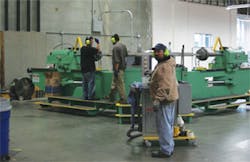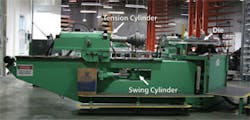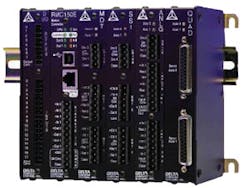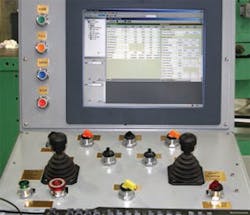Motion controller renews old machine
When LMI Aerospace Inc., St. Charles, Mo., wanted to bump up productivity on its machinery, it turned to electrohydraulic motion controllers to get the job done.
The provider of structural components, and assemblies to the aerospace, defense and technology industries wanted to increase productivity by updating the technology of an old hydraulic stretch forming machine, Figure 1, that makes aircraft parts, such as fuselage frames, wing skins, winglets, and nacelles. Built in the 1960s, the machine differed little from stretch forming machines that were first developed in the 1940s during World War II. The machine wraps a part such as an aircraft frame component around a die and pulls it to conform its shape to that of the die. When it was new, the machine had a very rudimentary open-loop hydraulic control system incorporating manual “bang-bang” valve controls. The operators had to bump switches on the control panel, which activated valve solenoids to move the stretch arms. Therefore, even when the machine was new, control of the stretching process wasn’t very precise.
The company made the switch a few years ago from the panel switches to using proportional hydraulic valves controlled by joysticks, which greatly improved control, but the accuracy and repeatability of the process were still not what they could be.
The width of the aluminum parts that are formed by the machine is typically about 1/2 in., and they need to be formed around the die with smooth and slow continuous motion. This requires precise control of the speed at which the arms move as well as the positions where the arms start and stop. Automating the stretch forming process would remove the need for the machine operator to be involved in finding the correct positions for each axis by hand every time the arms are moved.
LMI decided to initiate a project to upgrade the system to use an electronic motion controller because it needed repeatability and precise motion. An automated motion controller would give the machine precise control over forming speed and axis positioning, which would enable LMI’s aerospace customers to achieve more consistent processing.
Motion controller requirements
The motion controller needed to control four hydraulic axes simultaneously: two hydraulic cylinders that power the swing axes (under position control only) and two cylinders that power the tension axes (controlling both position and pressure). The swing axes extend around the die in a big arc, with the part to be formed held at each end by jaws attached to a tension cylinder that clamps it to one of the arms, Figure 2. While the swing arms are wrapping the part around the die, they need to maintain precise tension on it. Depending on the shape of the die and the geometry of the arms, the tension cylinders need to extend as the part is formed to avoid over-tensioning the part.
Pete Traphagen, of Traphagen Engineering, Ramona, Calif., was called on to design the new motion control system. In turn, Traphagen selected the RMC151E, the position– pressure control version of Delta Computer Systems’ RMC150 motion controller, Figure 3. Traphagen had used Delta motion controllers on projects in the past, and was familiar with using electrohydraulic controls to achieve precise motion. He has done manual tuning in the past, and selected Delta because of the support that comes from Delta for automating the tuning process. “Delta’s tools are as good as anything I’ve seen for tuning motion,” said Traphagen. “I’ve done PLC controls in the past and used their PID tuning tools and Delta’s are better. They’re miles ahead of manual tuning.”
“I have tried to use electrical servo controllers with hydraulics in the past and it’s much easier to use the Delta system,” said Traphagen. “While most of the other motion controllers are tailored for control of electrical servo systems, the Delta controllers are designed with special support for controlling hydraulic-powered machinery. For example, the Delta Controllers can control both position and pressure, and can smoothly transition back and forth between controlling force and position. This is very difficult to do with other equipment. This gives Delta a huge advantage in our type of application.”
Connecting and programming the controller
The new Delta RMC150 motion controller was interfaced to LMI’s existing machine with the addition of some new sensor devices. Absolute rotary encoders were used on the swing axes to measure the angle of the swing, while the tension axes were outfitted with linear transducers (string-operated encoders) for position feedback and pressure transducers mounted at the cylinders for pressure sensing. The hydraulics is driven via the same proportional servo valves that were previously on the machine. Integration of the RMC controllers is simplified because they provide direct connection to the transducers without requiring separate interface modules.
Traphagen programmed the motion using Delta Computer Systems’ RMCTools software package, which runs on a standard PC that was placed next to the motion controller in the operator’s console and connected to it via Ethernet (Figure 4). RMCTools allows the motion of an axis to be programmed via a set of motion instructions that are specified as part of a development project. A different part may have four different forming processes assigned to it, which Traphagen programmed as four different motion control projects. The RMCTools graphical interface was useful enough that Traphagen didn’t need to develop any additional human-machine interface (HMI) software.
Near-perfect results the first time
“When fine tuning the axes’ operation, the motion plots that are generated by RMCTools plot manager utility are invaluable in making adjustments,” said Traphagen. “You can get the motion curve as close to perfection as you want.” Traphagen used Delta’s automated tuning tools to get close, and then he made some manual adjustments to complete the tuning process.
The tuning tools are very important because the gains used in the control loop equations can differ significantly from axis to axis. For example, the position control loop gains used in the swing axes are about six times those of the tension axis, and the force gains differ by a factor of approximately 12. With such differences, manual tuning could be challenging. If one set of gains were used for all axes, it could make the system unstable. To prevent this condition, having automated tuning tools is helpful. “With Delta’s Tuning Wizard, we could do in minutes what would otherwise have taken hours,” said Traphagen. “We probably saved days off of our development schedule by relying on Delta’s tools.”
The integration of the new motion controller took less than a week, including programming and tuning. The tuning process took less than a day. Traphagen estimates that productivity has been improved significantly compared to what the machine could do when it was new, but more importantly, the machines’ operation is now more repeatable, with closer tolerances being maintained to produce a consistently high quality product.
For more information, visit www.deltamotion.com or contact the authhor at [email protected].
About the Author
Bill Savela, P. E.
Technical Marketing & Sales
Bill Savela, P.E., is technical marketing & sales director at Delta Computer Systems Inc., Battle Ground, Wash. He has more than 20 years of industrial process and motion control experience in applications engineering, marketing, and sales. He is a Registered Professional Engineer. and graduated from Michigan Technological University with BSEE and MS degrees. He has been at Delta Computer Systems, Inc. since 2002.
Contact him at [email protected] or visit www.deltamotion.com

Leaders relevant to this article:




